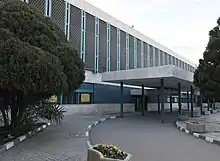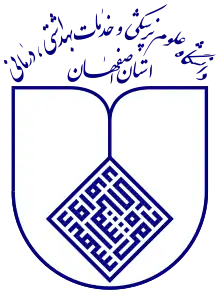Isfahan University of Medical Sciences
Isfahan University of Medical Sciences also known as Medical University of Isfahan (MUI) (Persian: دانشگاه علوم پزشکی و خدمات بهداشتی درمانی اصفهان) is a university specializing in basic medical sciences, clinical science, and health services, located in Isfahan, Iran.
| |
 | |
| Motto | « یا مَنْ اسْمُهُ دَواءٌ وَ ذِکْرُهُ شِفاءٌ » « نامش دارو و یادش درمان » |
|---|---|
Motto in English | O'Thou Whose Name is panacea, whose remembrance is heal-all. |
| Type | Public |
| Established | 1946 |
| President | Tahereh Changiz |
Academic staff | 939 [1] |
| Students | 10000 |
| Location | , |
| Campus | Urban |
| Colours | Persian green |
| Website | www |
 | |
Isfahan University of Medical Sciences is one of the most prestigious Iranian medical schools. Admission to the university is limited to students with top scores on the national entrance examination, administered yearly by the Ministry of Science, Research and Technology (Iran).
Isfahan ?? University of Medical Sciences was founded by Great Avicenna(Ibn_sina), under the patronage of the Kakouid ruler Alla-al-Dowleh in 1024/1025. It soon became one of the leading educational centers of the historic Muslim world. Isfahan University of Medical Sciences (IUMS), was established in 1946, as the Isfahan Higher School of Health Education. In 1950, the Isfahan Faculty of Medicine was inaugurated and students were admitted for the M.D. degrees after a 6-year medical training course.. Today, the university campus is located on Hezarjarib Street in southern Isfahan.
Isfahan University of Medical Sciences provides undergraduate, graduate and postgraduate programs in 10 faculties and 75 main departments. The student body consists of about 10,000 students from all 31 provinces of Iran and some foreign countries. Funding for Isfahan University of Medical Sciences is provided by the government (via the ministry of health and medical education) and through some private investments.
History
To the north of the Isfahan city centre lies an area called Dardasht, formerly known as Bab-ol Dasht, through which the Khiaban-e-Ibn Sina (Avicenna st.) runs. This ancient 11th century dome traditionally marks the spot where the great Sheikh-al-Rais Ibn-e-Sina, or Avicenna, as he is known in the West, established his school of medicine under the patronage of the Kakouid ruler Alla-al-Dowleh Mohammad, who had conquered the town from the Deylamid rulers at the start of the 11th Century.
Teaching at the school began as early as 1024 under the name of "Alaii School" (مدرس علایی )/Avicenna School(مدرس ابن سینا), making Isfahan University of Medical Sciences the oldest medical university in the world and the world's second-oldest university in continuous operation.

Avicenna settled in Isfahan and authored a five-volume medical encyclopedia: the Canon of Medicine (Al-Qanun fi't-Tibb). It was used as the standard medical textbook in Isfahan, the Islamic world, India, and Europe until the 18th Century.

According to Abu Ubayd al-Juzjāni, a pupil and a close companion of Avicenna, the students used to gather at the residence of Sheikh al-Raiss (Avicenna′s school) every night and would study his book of Canon and Shifā one by one under his instruction. The Canon still plays an important role in Iranian (Unani) medicine.
Avicenna (Ibn Sina) has been described as the "father of early modern medicine." He is credited with various medical observations and discoveries, such as recognizing the potential of airborne transmission of disease, providing insight into many psychiatric conditions, recommending the use of forceps in deliveries complicated by fetal distress, distinguishing central from peripheral facial paralysis, and describing guinea worm infection and trigeminal neuralgia. His works cover subjects including angelology, heart medicine, and treatment of kidney diseases.
Avicenna (Ibn Sina) was also a pioneer of experimental medicine, evidence-based medicine, pharmaceutical sciences, clinical pharmacology, aromatherapy, pulsology, and sphygmology.
The school of medicine in Isfahan by Avicenna became the representative of Islamic (Irani) medicine mainly through the influence of Ibn Sina's famous work al-Canon fi Tibb. The book was originally used as a textbook for instructors and students of medical sciences in the medical school of Avicenna.

Abu ubaid al juzjani was a famous pupil of Avicenna. He spent many years with his master in Isfahan, becoming his lifetime companion. After Avicenna's death, he completed Avicenna's autobiography with a concluding section. He and the other students of Avicenna continued teaching in Avicenna's school in Isfahan.

Also, Ibn Miskawayh (Persian: مُسکویه, 932–1030) was a Persian chancery official of the era, and a philosopher and physician that taught in the Isfahan school of medicine. As a Neoplatonist, his influence on Islamic philosophy is primarily in the area of ethics. Ibn Miskawayh was one of the first to clearly describe a version of the idea of evolution.
The idea to establish the modern university came from doctors at the Amin Hospital in 1939. Finally, the hospital's board of directors approved a plan to establish the Isfahan Higher Institute of Health in 1946. Isfahan University of Medical Sciences was established as a modern institution in 1946 under the name "The Higher Institute of Health" and later was elevated to the "School of Medicine".
In September of the same year, an ad signed by lecturer Dr. Jelveh, then caretaker of Isfahan Province Health and Medical Treatment Department, was published in local newspapers calling on prospective students to enroll in the new institute.
The first classes were held at the old Sa'di High School (now the Soureh Institute). Many more students enrolled in subsequent years. Therefore, the institute had to find a larger campus to accommodate the growing number of new students. As a result, the Isfahan University was founded to accommodate these students and establish new faculties.
On October 29, 1950, the first series of classes were held at the new campus, named the University of Isfahan. The newly established school of Medicine at Sa'di School and Literature College on Shahzadeh Ebrahim Street joined the University of Isfahan and relocated themselves to the main campus.
The university later offered programs in human sciences, engineering and medical sciences. Related programs of medical sciences, although they were the parent programs of Isfahan University, were then separated from the University of Isfahan and became an independent university named Isfahan University of Medical Sciences(IUMS) in 1985.
With 12 hospitals and 75 departments, the university is currently a regional health care provider and the main medical center in Isfahan Province and central Iran.
Schools
- School of Health
- School of Nursing and Midwifery
- School of Medicine
- School of Nutrition & Food Sciences
- School of Pharmacy & Pharmaceutical Sciences
- School of Dentistry
- School of Rehabilitation Sciences
- School of Advanced Technologies in Medical Sciences
- School of Allied Medical Sciences
- School of Management & Medical Information Sciences
Research
Isfahan University of Medical Sciences (MUI) is one of the most prominent and highly-prestigious medical universities in Iran. MUI aims to:
- Make a substantial contribution to medical research nationally and internationally
- Work with health care providers, health care education providers, patients and the public, to ensure medical education / research has real-world impacts
- Provide high quality medical education / research for students and researchers
- Providing innovative solutions for health challenges
MUI provides and fosters innovative research that advances knowledge and translates new discoveries to improve the health and well-being of individuals and communities. International cooperation with the German partners in the following fields is of special importance
- Development of Novel Therapeutics and Diagnostics/ Theranostics
- Artificial Intelligence and Information Technology in Medicine
- Regenerative Medicine and Cell Therapy
- Big Data to Knowledge
- Precision Medicine
- Medical Robotics
Several cooperation projects in recent years have been initiated with German universities. To name a few examples of successful projects:
- Student exchange in the field of IT with the University of Passau running since 2015
- joint international conference on climate protection with the strong involvement of professors from Germany
- Joint research project in the field of intercultural communication in cooperation with HU Berlin (in work).
IUMS has one of the largest network of research in medical sciences. Besides the research done in different departments of its faculties, it is now handling several research centers in central Iran.
IUMS Journals
Isfahan University of Medical Sciences (IUMS) currently publishes 14 peer reviewed journals in different fields of basic and clinical, medical and paramedical sciences. Many of these journals are indexed by international indexers.
Online management services for editorial workflow of university journals were established in 2004 and became fully operational by 2005.
Hospitals
MUI governs 17 training hospitals which provide health services for the people of Isfahan province and also neighboring provinces. Students, Externs, interns and residents are trained in these hospitals by attending faculty of MUI training hospitals.
See also
External links
References
- "Academic staff(2019)". Isfahan University of Medical Sciences. 2019. Retrieved October 16, 2019.
